MAKE A SPLASH
THIS SUMMER
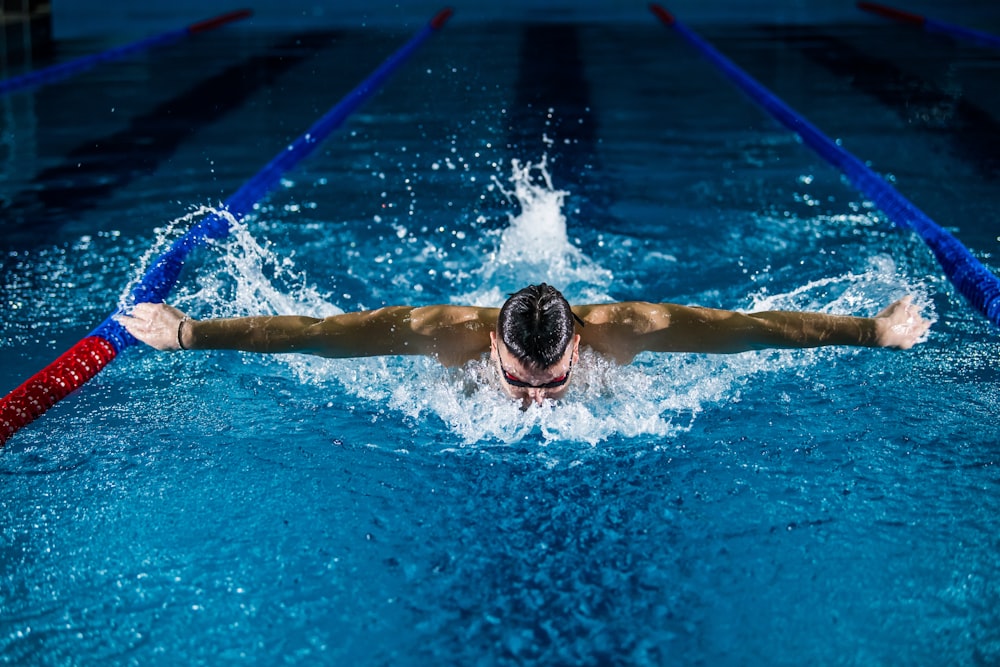
Join Now For $0 Enrollment!
Learn MorePosted By: Chicago Athletic Clubs /
A training sandbag is a versatile and durable training tool filled with sand for sandbag workouts. Unlike traditional weights like barbells and dumbbells, the shifting sand inside the bag enhances balance and core stability, providing unique training benefits rooted in functional fitness.
Equipped with handles for lifting, carrying, and pushing, training sandbags offer a full body workout with limitless movement options, making them an excellent addition to any home gym. They are especially helpful in functional strength development, useful in real life activities like manual labor, where strength and coordination are required under unstable conditions.
Suitable for all fitness levels, these sandbags are ideal for both cardio training and muscle building. Sandbag lifting is a great way to challenge your stabilizer muscles and test your endurance, whether you’re doing forward lunges, Sandbag Squats, or even good mornings.
With adjustable weights and dimensions, they are popular among a wide range of athletes —from Strongman competitors to martial artists —as they effectively develop grip strength, endurance, and good posture, which are often difficult to achieve with traditional weights.
The benefits of a sandbag workout go far beyond lifting for aesthetics. Sandbags, like all irregular objects, significantly challenge your stabilizer muscles and grip strength. Unlike barbells and dumbbells, which are specifically designed for lifting, sandbags are not naturally engineered to align with your center of gravity.
Sandbag training can be performed at home, outdoors, in a garage gym, or at a commercial gym. You can incorporate sandbag exercises into solo workouts, paired sessions, or group circuits. These exercises are ideal for developing lower body strength, improving heart rate conditioning, and delivering a great workout across a range of exercises.
The uneven and awkward nature of sandbags forces your body to work hard to control the shifting mass, naturally building core stability alongside strength. This results in becoming a more robust and all-around stronger athlete.
Using sandbags engages all three types of grip strength (pinch, crush, and support). You need to pinch the sandbag while lifting, and crush and support it while holding and carrying it. Sandbag getups, push press, and high pull are just a few examples that incorporate grip and entire body tension.
These exercises present a real challenge for your body to adapt to, which is crucial for lifelong fitness dedication.
Simply put, sandbags offer numerous real-life applications beyond traditional fitness tools. Their heavy and awkward nature, with weight shifting during movement, demands fluid motion. While machines and barbells do have their benefits, neglecting sandbags can create a gap in your overall physical capability, particularly if your job requires real-world physical competence.
For example, carrying a heavy sandbag in the crooks of your elbows mirrors everyday challenges, building useful strength. Even exercises like Bear Hug Squats, Sandbag Back Squats, and Turkish get-ups provide carryover to activities like lifting children or heavy boxes.
Choose an appropriate lb sandbag. Perform each exercise for 45 seconds, resting for 30 seconds between exercises. Complete the entire circuit 4-6 times for a full-body workout.
-Be comfortable with being uncomfortable. If it feels easy, it is easy-- that won't really do much. Try a heavier weight. You should really want to be done by the last few reps of any given exercise. If you aren't challenging yourself you won't change.
-Ensure you are using enough weight to challenge yourself, but still maintain good posture.
-Focus on your breath. Exhale on exertion. It will help you get through even the most demanding training session.
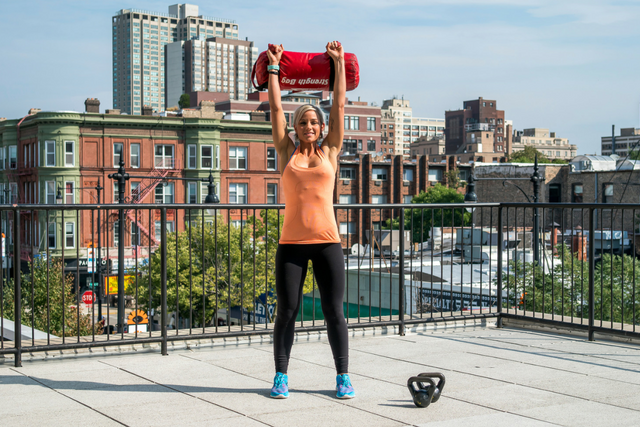
After pushing the chest out to protect your back, squat down to grab the bag. Grasp under the bag exploding the hips forward, straightening the legs then using your arms pull and guide the sandbag up to chest level. Gather yourself, then dip your hips, keeping your back tight.
Explode up into an overhead press or shoulder press, guiding the bag overhead. Bring the bag down under control, absorbing the force with a slight bend in the knees, then control it back to the floor.
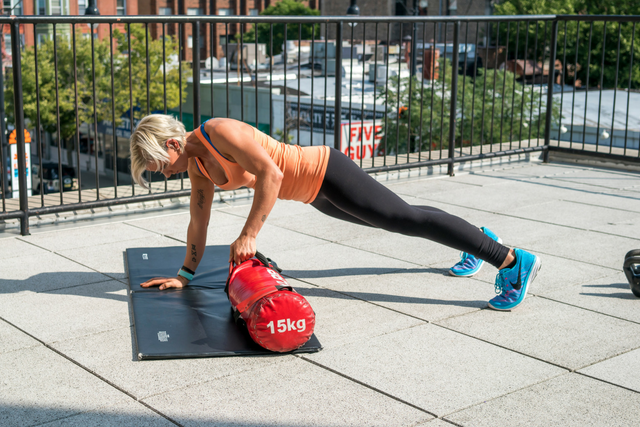
Get into plank position with sandbag beneath your chest. Use one hand to slide bag forward and back under body, keeping hips level to the floor. Switch arms as you push the sandbag left and right—mimicking lateral pull movements. This is a solid core challenge that is useful for functional strength.
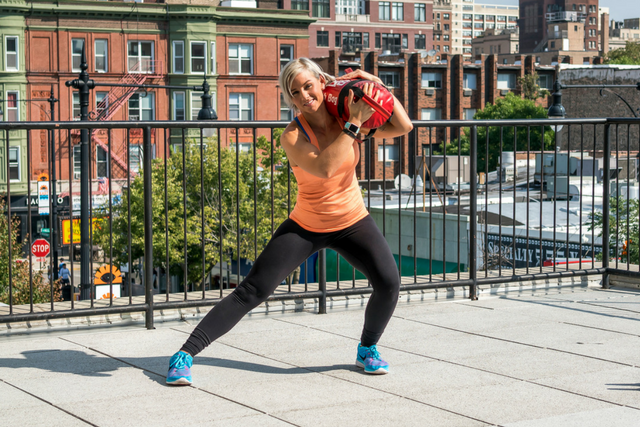
Load the sandbag onto one shoulder. Take a wide step to the side with the bag. When your outside foot contacts the ground, lower your body by pushing your hip back and bending the knee. Keep your inside leg straight and your foot firmly planted.
Pause when your outside thigh is parallel with the ground, then push back to the starting point. Swap the bag to the opposite side each round. Be sure your feet land in a straight line, about feet shoulder-width apart.
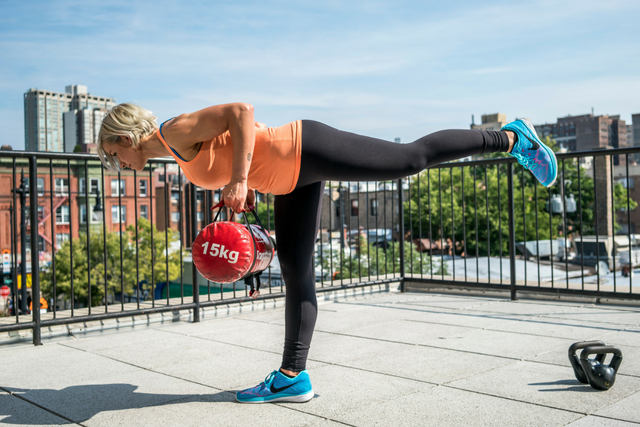
Holding the sandbag with both hands, stand with feet hip-width apart, knees slightly bent. Bend forward at the hip while extending one leg back. Continue bending until you are parallel with the ground. Then return to the upright position. Focus on one leg per circuit. Switch to the opposite leg for the next circuit.
After your sandbag workout, it's important to cool down with a series of stretches to help your muscles recover and improve flexibility.
Begin with a forward bend stretch by standing with your feet hip-width apart. Slowly bend forward at the hips, reaching towards the ground and letting your head and neck relax. Hold this position for 30 seconds to stretch your hamstrings, lower back, and calves.
Next, move on to the quad stretch. Stand on one leg and use a wall or chair for support if needed. Bend your other knee, bringing your heel towards your glutes, and grab your ankle to gently pull. Hold this stretch for 30 seconds on each side to target your quadriceps and hip flexors.
For the hip flexor stretch, step into a lunge position with your right foot forward and your left knee on the ground. Push your hips forward gently while keeping your upper body straight. Hold this stretch for 30 seconds on each side to stretch your hip flexors and psoas muscles.
To open up your chest, try the chest opener stretch. Stand with your feet hip-width apart and clasp your hands behind your back. Straighten your arms and lift them slightly while opening your chest and squeezing your shoulder blades together. Hold this stretch for 30 seconds to benefit your chest, shoulders, and biceps.
Move into the child's pose by kneeling on the floor, sitting back on your heels, and reaching your arms forward to lower your torso between your thighs. Hold this pose for 30 seconds to stretch your back, shoulders, and hips.
For the seated forward bend, sit with your legs extended straight in front of you and reach forward towards your toes, keeping your back straight. Hold this position for 30 seconds to stretch your hamstrings, calves, and lower back.
Perform the cat-cow stretch by starting on your hands and knees. Alternate between arching your back (cow pose) and rounding it (cat pose) for 10 cycles. This movement helps stretch and mobilize your spine, shoulders, and neck.
Next, do a shoulder stretch by bringing one arm across your body at shoulder height and using the opposite arm to gently pull it closer to your chest. Hold this stretch for 30 seconds on each side to target your shoulders and upper back.
For the triceps stretch, raise one arm overhead and bend the elbow, reaching down towards your back. Use the opposite hand to gently push on the elbow. Hold this position for 30 seconds on each side to stretch your triceps and shoulders.
Finally, try the figure four stretch by lying on your back and crossing one ankle over the opposite knee. Pull the uncrossed leg towards your chest and hold for 30 seconds on each side. This stretch will help loosen your glutes, hips, and lower back.
Throughout the entire movement, remember to breathe. This post-exercise conditioning tool helps restore your range of motion and reduce muscle tension.
Best sandbag exercises mimic real movement and challenge every muscle group. Whether you're in it for fitness, function, or fatigue-resistance, sandbags are the best way to train with purpose. Want more? Search forums, consult a personal trainer, and refine your training methods.
DONNA WALKER is a Trainer at our CAC Lakeview Athletic Club
To book a session with Donna at LVAC, click here
| Chicago Athletic Clubs
| Chicago Athletic Clubs
| Chicago Athletic Clubs
| Chicago Athletic Clubs
| Chicago Athletic Clubs
© 2025 Chicago Athletic Clubs. All Rights Reserved. Privacy PolicyEmployee Login
https://www.chicagoathleticclubs.com/
https://www.chicagoathleticclubs.com/services/personal-training/
0
5000
true